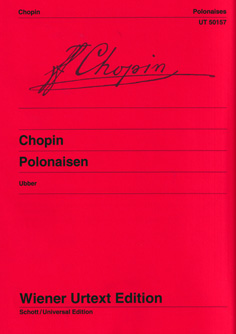| ||
The recent edition of the Polonaises published by Wiener Urtext Edition has stolen a march on the long-awaited one by Peters. [WIENER URTEXT EDITION: UT 50157
Frédéric Chopin | Polonaisen | Nach den Quellen herausgegeben und mit Fingersätzen und Hinweisen zur Interpretation versehen von Christian Ubber (pp. XXI + 192). Wiener Urtext Edition, Schott/Universal Edition Wien 2018 - ISMN 979-0-50057-411-8]
WHEN you are forced to repeat the same things, writing a review can become an unpleasant and annoying task. And furthermore, a review should be useful and, within certain limits, should be able to make a contribution too. Nevertheless, we will review—only in part—the recent edition of Chopin's Polonaises published by Wiener Urtext only out of a commitment to our visitor-readers. So, after some general notes we will examine—again partly—two Polonaises, that is to say that in the G-flat major and the Polonaise-Fantaisie.
The editor, Christian Ubber, is not a philologist, but a musicologist representative of the new modern culture that requires no special knowledge or specialisation, but only bombastic shallowness, i.e. a semblance of pseudo-culture, the kind—to put it bluntly—that university degrees have been guaranteeing with cloying impudence for some decades.
The editor begins his Preface[1] by quoting a rhetorical and vague judgment of Liszt, but forgets the very negative one given by Liszt himself on the Polonaise-Fantaisie. Then follows another no less fatuous quotation from Jim Samson, the editor of an embarrassing edition of the Ballades. In this way, Ubber seems to want to declare who his tutelary deities are for the constitution of the text of the Polonaises. After the Preface, there follow perfunctory “Notes on Interpretation (Hinweise zur Interpretation),” from which it is clear that the editor understood almost nothing of the new piano school devised by Chopin, and based on the quality of touch. How many platitudes!
As for the constitution of the text, Ubber does not cite any aids: it seems that everything, or almost everything, derives from purely personal studies. In fact, he ignores all previous editions, even though he has consulted and used them. For example, in the small chapter "Lesartendivergenzen als Quellen für die Aufführungspraxis der Polonaise op. 53 [Variant readings as sources for performance in Op. 53]" (p. IX, translated on p. XV), about mm. 28, 44, 76, 166 he says: "The autograph engraver's copy for the German first edition and the English first edition give the appoggiatura octave e′′♭/e′′′♭ without a′′, the French first edition in b. 28 by contrast with a′′, possibly as a subsequent correction by Chopin. [...] The notation of the French edition and the suggestion in Mikuli's edition to connect the a′′ of the appoggiatura to the a′′ of the principal note with a tie further clarify the execution intended by Chopin.”
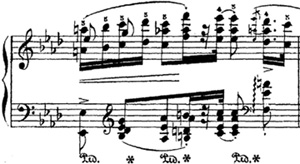 These are not "Lesartendivergenzen [variant readings], but different writings of the same lectio. In any case, apart from the obvious consideration that a musical example would have taken up less room and would have been much clearer, compare what we said in our edition (p. 169): "The writing adopted by Mikuli suggests the exact execution of the appoggiatura!" Here we may add that, before Mikuli, Klindworth, the editor—according to Liszt—of the best Chopin edition (see our introduction to the edition of the Preludes, p. XII), had already suggested the same execution in his Moscow edition (see image on the right). These are not "Lesartendivergenzen [variant readings], but different writings of the same lectio. In any case, apart from the obvious consideration that a musical example would have taken up less room and would have been much clearer, compare what we said in our edition (p. 169): "The writing adopted by Mikuli suggests the exact execution of the appoggiatura!" Here we may add that, before Mikuli, Klindworth, the editor—according to Liszt—of the best Chopin edition (see our introduction to the edition of the Preludes, p. XII), had already suggested the same execution in his Moscow edition (see image on the right).There are no variants in the music text: for Ubber, variae lectiones
do not exist. At times some differences are noted at the foot of the page, but in an entirely uncritical manner. There is no trace of real recensio.
From p. 146 to p. 192, one finds the "Critical notes [Kritische Anmerkungen]", followed by an English translation, which does not always (!) translate the German text in full and faithfully (e.g. the small chapter on p. VIII "Eingang in der Polonaise KK IVa Nt. 8"—indeed among the most hilarious digressions—has not been translated!). Such a Critical Notes should indeed be called Beschreibung der Verschiedenheiten, i.e. Description of the differences, since there is nothing really kritisch inside them. They are subdivided into “Sources (Quellen)”, “Source Evaluation and Edition (Quellenbewertung und Edition)” and “Detailed Notes (Einzelanmerkungen)”; in some cases, space is devoted to “Repetitions [Wiederholungen]”, and other observations (e.g. "Corrections by a foreign hand [Fremdkorrekturen, an amusing neologism]). In short, a rather muddled set that requires a lot of good will from the reader.
The main novelty of this edition lies in the multiplication of source abbreviations. The autograph is correctly initialled A, which, however, is transformed, e.g. for the Polonaises Op. 26, into fSt, whose meaning is “Autograph engraver's copy for the French First Edition [Autographe Stichvorlage zur französischen Erstausgabe])". Such a proliferation of abbreviations—we had already observed a similar oddity with regard to Henle re-editions by Müllemann—takes up space without benefiting clarity. And let us get to the Polonaise in G flat major, the one that great scholars like Niecks and Huneker believed to be false. 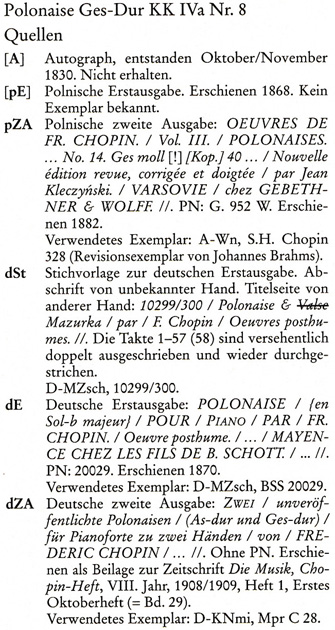 Here is the list of sources given by Ubber (left): with [pE] is initialled the “Polish First Edition, Joseph Kaufmann, Warszawa, 1868. No copy known” (an English translation—as you can realize—which does not follow the German text). Here is the list of sources given by Ubber (left): with [pE] is initialled the “Polish First Edition, Joseph Kaufmann, Warszawa, 1868. No copy known” (an English translation—as you can realize—which does not follow the German text). 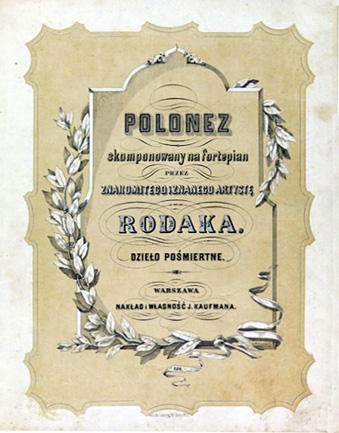 The last statement would be enough to justify sending this edition for pulping. In fact, the Polish first edition exists and is available to anyone who wants to consult it. Here on the right, we reproduce its title page. But let us proceed. The last statement would be enough to justify sending this edition for pulping. In fact, the Polish first edition exists and is available to anyone who wants to consult it. Here on the right, we reproduce its title page. But let us proceed.(We have not got the second Polish edition published by Kleczyński, i.e. pZA, but only the separate edition that Gebethener & Wolff published later [Édition de Jean Kleczyński | revue et corrigée d'après les premières autorités pédagogiques | et artistiques | par Rodolphe Strobl] with the same publication number: G.952. W.)
The handwritten copy used by Schott for his 1870 edition is abbreviated dSt. Ubber on p. 58 reproduces the first page of this copy, which in itself would be of no value, but serves to establish a disconcerting filiation (see below).
After the Schott edition (dE) the last source is dZA, published as an insert in the issue entirely dedicated to Chopin by the magazin "Die Musik". According to the “Anmerkungen zu unseren Beilagen”, the text would reproduce the copy prepared by Oskar Kolberg, Chopin's childhood friend.
And here is Ubber's Quellenbewertung. Let us begin with the first sentence: “The Polonaise in G flat is transmitted in two strands of sources. One is represented by dSt and pZA, which in turn are based on the [pE] which has not survived, the other by dZA, which is based on a lost copy by Chopin's childhood friend Oskar Kolberg, which was clearly based on the original manuscript [A].” En passant, we will say that Chopin's friend was not Oskar, but Wilhelm (Wiluś)! So, according to Ubber, dZA would be based on the lost copy made by Kolberg, who would have had Chopin's manuscript at his disposal. This statement boldly combines the apathetic musicologist with the papier-mâché philologist. Well, let us glance through the Oskar Kolberg's Correspondence.[2]
We will not chronicle the correspondence between Kolberg and the publisher Breitkopf, but limit ourselves to the most significant letters. With the rights expiring thirty years after Chopin's death, on 5 January 1878 Kolberg suggested to Breitkopf a new edition of all the composer's works.[3] An obviously opportunistic proposal! Breitkopf, accepting the suggestion, bustled about and put together an editorial committee made up of Bargiel, Rudorff, Liszt, Brahms and Reinecke (but not including Kolberg...; however, for Chopin's early not published works Breitkopf relied mainly on the latter, of course).[4] A few months later, on 27 June 1879, Breitkopf wrote to Kolberg: “Dear Sir, for our edition of Chopin we are currently still missing two compositions: 1. the Mazurka in A minor, vol. XIII no. 13; 2. the Polonaise in G flat major, vol. XIII no. 21. The original editions, according to the publisher's information, are sold out;”[5] and he urges Kolberg to seek from friends and acquaintances all he can find.
On 18 August 1879 Breitkopf, in sending Kolberg vols. III and X of the Gesamtausgabe, asks: “Since our missive of 27 June regarding the two dubious compositions, the Mazurka in A min. and the Polonaise in G-flat major, have you managed to get any more precise information?”[6] Kolberg, however, had nothing in hand and wrote to Sikorski on 27 September: “[...] The second request is to find Chopin's Polonaise in G-flat major... published twenty years ago by Kaufman (under the title Polonez sławnego artysty, zmarłego niedawno w Paryżu [Polonaise by a famous artist, who died some time ago in Paris]).”[7] On 9 October 1879 Breitkopf insists: “We repeat our previous request that you very kindly send us the originals of the two pieces, if you can.”[8] On 15 December 1879, Kolberg also asked Tytus Wojciechowski, who, however, being ill, was in no state to respond.[9] On 13 February 1880, Kolberg questioned Michalina Wierzbowska too,[10] and on 2 June 1880, he finally contacted Jan Kleczyński.[11] In short, Kolberg no longer knows which way to turn for finding the Kaufman edition of the Polonaise, even though he ensures that he had got it (actually, he remembers that the author's name, i.e. Chopin's, was missing from it).[12] On 13 August Sikorski replied to him, saying that he had found no copy of the Polonaise, but that Kleczyński had undertaken to transcribe it for him. Finally on 20 September Kleczyński sends the transcribed copy of the Kaufman edition, but Kolberg is not at home (he was in Kołomyja); a week after his return, on 25 November he thanks Kleczyński![13] On the basis of Kleczyński's copy, Kolberg prepares his own copy for Breitkopf, even though the time is long overdue: "Dear Sirs," Kolberg writes on 5 January 1881, "I have the pleasure of sending you enclosed the best version of the Polonaise in G-flat major, which is circulating in copies."[14] He asks for an expense allowance of 15 marks and adds some rather fanciful news: “The Polonaise was known as the Farewell Polonaise (Les adieux de Varsovie).[15] It was written in 1830 shortly before his departure for foreign countries only for his close friends and fellow students, and Chopin, while he was alive, did not think at all of having it published (although this was done later and not without mistakes).”[16] Breitkopf replied on 21 April 1881: “We apologize very much for the delay in replying and for the 15 marks we have only recently arranged payment for.” But he added a somewhat sibylline sentence: “The last manuscript you sent us should be added to the complete edition; perhaps a few more pieces can still be found. Even if all these late arriving compositions are not of exceptional value, it is not legitimate to make a selection, but everything is definitely by Chopin should be accepted.”[17] In other words, Breitkopf sensed that something was amiss. The fact is that, when Kolberg on 10 April 1885 (a request he repeated on 9 May)[18] asked for some printed copies of the Polonaise in G-flat major, Breitkopf replied on the 15th of the same month: “As for the aforementioned Polonaise in G-flat major, we ourselves had thought of including it in the Gesamtausgabe, leaving, though, the final decision to the editorial committee, which unfortunately rejected it.”[19] Thus, from the Kolberg correspondence we can deduce with certainty that the manuscript copy sent to Breitkopf was none other than the copy's copy prepared by Kleczyński!
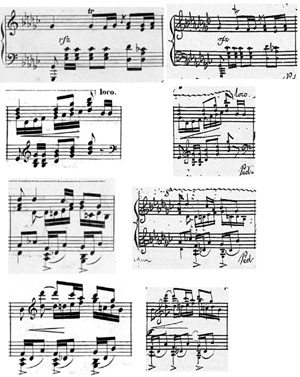 The Kaufman edition (which we will call PE), whose title page we reproduce above, bears the following title: "Polonaise | composed for piano | by an eminent and well-known artist | compatriot." A somewhat different title from the one Kolberg mentions. This edition—according to the notes on www.polona.pl—was wrongly classified in Stefan Burhardt's catalogue of Polonaises as a work by Feliks Jaroński, and is dated 1865, five years before the Schott edition. The music text is, however, that of our Polonaise. The Kaufman edition (which we will call PE), whose title page we reproduce above, bears the following title: "Polonaise | composed for piano | by an eminent and well-known artist | compatriot." A somewhat different title from the one Kolberg mentions. This edition—according to the notes on www.polona.pl—was wrongly classified in Stefan Burhardt's catalogue of Polonaises as a work by Feliks Jaroński, and is dated 1865, five years before the Schott edition. The music text is, however, that of our Polonaise. We cited above the reproduction of the first page of the manuscript copy (dSt) from which the Schott edition was drawn. Well, the collation makes it possible to establish with relative certainty—for absolute certainty it would indeed be necessary to collate the entire manuscript[20]—that dSt is the apograph, i.e. the handwritten copy, of PE (see the measures in comparison on the right). M. 13: PE places an unnecessary ♭ before C, which dSt copies. — M. 18: PE stops the 8va with loco (typically Chopinian usage), which dSt writes out. — Mm. 21 and 23: PE omits the ♭ before the last D of the r. hand., and dSt does not correct the error. The small differences between PE and dSt are due to engraver's oversights (such as the missing p in m. 1) or to unnecessary interventions by Schott's proof-reader.
From the above we can rule out the Schott edition together with its antigraph from the recensio, since it is based on PE. But the G&W edition edited by Kleczyński is also to be ruled out, since, as the Kolberg correspondence cited above shows, it too is based on PE. For the recensio, therefore, any editor has to collate both PE and the edition published by “Die Musik”, which we will name GE2. In the "Notes to our inserts" we read: "[...] the second (Polonaise), in G-flat major, also a youthful work by the master, presents all the traits of his genius. Mr. A. Polisńki, who has made it available to us in a friendly manner, informs us that the original does not exist, but there is a copy in the hand of Chopin's childhood friend, Oskar Kolberg, the well-known ethnographer and publisher of a mighty 37-volume collection of Polish folk songs. Kolberg, almost presenting his friend's later celebrity, transcribed many of his early compositions, piano pieces and songs, which were published after the composer's death." We now know that this is a false statement, as Kolberg never saw the autograph of this Polonaise. It is likely that A. Polisńki attributed his copy to Kolberg in order to enhance it. He was however misinformed: in fact—we repeat—it was not Oskar who was Chopin's friend, but Wilhelm, and Kolberg's copy was perhaps still in Breitkopf's hands. It would have been more useful to know how Polisńki got that copy.
The collation of GE2 makes it possible to establish with certainty that its antigraph was different from the one used for PE. First of all, it preserves measure 32, which in PE is missing; moreover, in Trio the key signature's change starts from m. 103, whereas in PE it starts from m. 104. Ubber did not even notice that! Yet there is an important concordance: in m. 35 PE reads “alter. node” between the staves, while GE2 has “al ter.: moda”.[21] The different reading suggests that two different engravers have interpreted the same incomprehensible expression differently. From this, together with other considerations, we can deduce that PE derives from a copy whose antigraph was the same as that from which the antigraph of GE2 derives. To summarise, from an autograph still in the sketch stage, though complete, the Polonaise was assembled by an unknown (*CX0), from which two copies, *CX1 and *CX2, were taken by different copyists, which were corrected independently of each other, and from them PE and GE2 were drawn. If that bizarre expression was in the autograph, it is much more likely that Chopin had written “alternando (le mani)”, i.e. alternating (the hands), as “node” of PE suggests. In other words, the second quadruplet of demisemiquavers with the following dyad is to be played by the left hand, while the two corresponding chords in the lower staff are to be played by the right hand, which in this way does not even have to move. This is reminiscent of the arpeggio in the first Polonaise in G minor, mm. 5 and 9. Thus, on the basis of PE and GE2 it is possible to establish a text quite close to *CX0, no more.
Lastly, what is dismaying is that the Polish national edition (vol. 26 B II, Source Commentary, p. 16), published in 2006, ignores the existence of PE: "... today, not a single copy is known"!
Since we have gone on too long,... ...we will devote only a few remarks to the Polonaise-Fantaisie. In the introductory note to the "Einzelanmerkungen" (p. 168, transl. p. 190) Ubber repeats what he had written a little earlier about Op. 44: "Chopin notated arpeggio signs as perpendicular slurs. The present edition uses the arpeggio signs customary today.” Obviously he is very careful not to prove his erroneous statement (see our review of the Barcarolle).
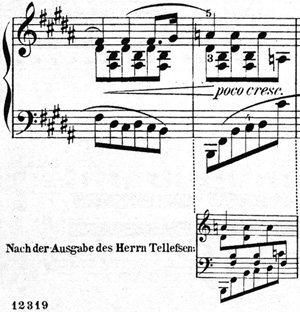 — M. 20. The last B is B sharp, which is the authentic lectio. Yet no pianist plays that B sharp and no modern edition accepts such a B sharp. Yet Ubber does not comment on it anything, so that any student may think it is a typo!! — M. 174. The first German and English editions reproduce the text of the two autographs, while the first French edition contains a correction: the engraver deletes the A and replaces it with an F, but does not delete the natural, which he has in front of him. Why? A plausible answer is given by Tellefsen in his edition: he moves the natural before C. Given the rarity of Tellefsen's corrective interventions, his m. 174 should be considered a varia lectio. Klindworth was also of the same opinion: in his Moscow edition, in fact, he put it in a footnote, while in the European edition (Ed. Bote & G. Bock, see picture on the right), he places it straight as a variant. — M. 20. The last B is B sharp, which is the authentic lectio. Yet no pianist plays that B sharp and no modern edition accepts such a B sharp. Yet Ubber does not comment on it anything, so that any student may think it is a typo!! — M. 174. The first German and English editions reproduce the text of the two autographs, while the first French edition contains a correction: the engraver deletes the A and replaces it with an F, but does not delete the natural, which he has in front of him. Why? A plausible answer is given by Tellefsen in his edition: he moves the natural before C. Given the rarity of Tellefsen's corrective interventions, his m. 174 should be considered a varia lectio. Klindworth was also of the same opinion: in his Moscow edition, in fact, he put it in a footnote, while in the European edition (Ed. Bote & G. Bock, see picture on the right), he places it straight as a variant.The fingerings proposed by Ubber, when they are not banal, are among the most anti-Chopinian ones you can conceive. We are faced by a cumbersome and boring edition, which is hardly advisable. From a philological point of view it is a mess, and from a piano-playing standpoint it is better to keep silent. Of course Christian Ubber does what he is able to do, so he bears no responsibility. As a rule, the real culprits are the editors-in-chief of the various publishing houses, who, being specialists in incompetence, entrust Chopin editions to hopeless people.
Of the volumes devoted to Chopin by Wiener Urtext (Ballades, Scherzi, Nocturnes and Impromptus were edited by Ekier, but—be careful—they are not the duplicate of those published by Wydanie Narodowe; the Preludes by Hansen) only the Etudes edited by Badura-Skoda deserve to be preferred by students. Unfortunately, these Polonaises are not worthy to stand next to those Etudes. Hence, for the time being, the only usable edition of the Polonaises, despite all its flaws, is the Polish National Edition.
Final statement.—We regret to inform our readers that this is our last review of a Chopin edition. When Badura-Skoda, very busy in musician's paradise, manages to finish the edition of the Third Sonata, announced by Bärenreiter years ago, perhaps we will be able to make one last effort. Perhaps, though.
NOTES. [1]
The Preface is written in German, followed by an English translation; the French version, however, is abrégée, abbreviated (!).
[2]
Oskar Kolberg, Dzieła Wszystkie: Korespondencja, I÷III, Warszawa (Ludowa Spółdzielnia Wydawnicza) 1965÷1968.
[3]
Cf. op. cit. II, p. 95.
[4]
Letter of 8 January 1878 (erroneously dated 1880, cf. op. cit. II, p. 98 f.).
[5]
Cf. op. cit. II, p. 241.
[6]
Cf. op. cit. II, p. 249.
[7]
Cf. op. cit. II, p. 257.
[8]
Cf. op. cit. II, p. 260.
[9]
Cf. op. cit. II, p. 286.
[10]
Cf. op. cit. II, p. 323.
[11]
Cf. op. cit. II, p. 369.
[12]
In fact, in his letter to Sikorski erroneously dated 10 August 1880 (cf. op. cit. II, p. 398 ff.) Kolberg says that he had three copies in his possession, which, once he had lent them, he never saw again.
[13]
Cf. op. cit. II, p. 423.
[14]
Cf. op. cit. II, p. 446.
[15]
This recalls the initial annotation on the manuscript copy of the Polonaise in B-flat minor dedicated to Oskar's brother Wilhelm: Les Adieux, later corrected to Adieu.
[16]
In our opinion, the style and workmanship place the date of composition well before 1830: it is the work of a teenager who wants to show his muscles.
[17]
Cf. op. cit. II, p. 476.
[18]
Cf. op. cit. III, p. 238 and 252.
[19]
Cf. op. cit. III, p. 254. We wrote to Breitkopf to find out what might have happened to this manuscript. The courteous and prompt reply was that nothing remained of the Gesamtausgabe documentation.
[20]
When we began collecting material for our edition of the Polonaises at the end of the last century, we also wrote to Schott several times, but received no reply.
[21]
Ubber writes: “dSt, dZA: alter. moder. or alter. moda resp., i.e. 'the other way of playing' (after una corda this means tre corde).” There is just one small problem: in Italian, that expression, besides being wrong in itself, does not exist.
[2022 © Franco Luigi Viero] | ||
 | ||
